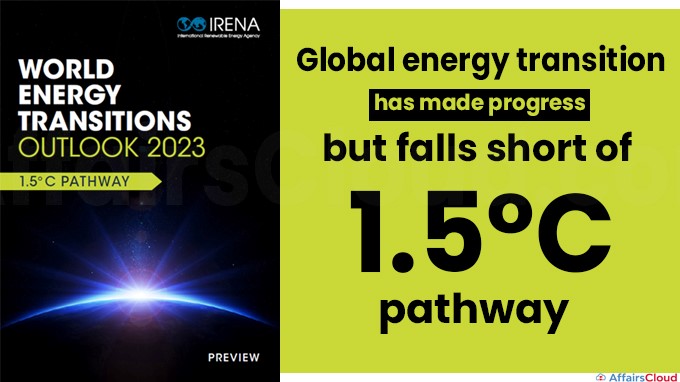
Disclaimer: Copyright infringement not intended.
Context
- Recently, the report, ‘World Energy Transitions: Outlook 2023’ was released.
About the Report
- World Energy Outlook is International Energy Agency's flagship publication.
- It is an annual report and it appears every year since 1998.
- WEO presents detailed projections of energy demand, production, trade and investment, fuel by fuel and region by region.
- Its research and objective data offer crucial insights into the world’s energy demand and supply under various scenarios, as well as the implications for energy security, climatic goals, and economic development.
Findings of the 2023 WEO Report
Energy Transition in Power Sector
- Progress has been made in the energy transition, particularly in the power sector where renewables account for 40 per cent of installed power generation globally and contribute to an unprecedented 83 percent of global power additions in 2022.
Global Energy Transition
- The global energy transition is still “off-track” and falls short of the 1.5 degrees Celsius pathway.
- The aftermath of the Covid-19pandemic and the ripple effects of the Ukraine crisis have further compounded the challenges facing the transition.
Limited Deployment
- Deployment is limited to certain parts of the world, the report pointed out.
- China, the European Union and the United States accounted for two-thirds of all additions last year, leaving developing nations further behind.
Inequitable Renewable Energy Investment
- In 2022, 85 per cent of global renewable energy investment benefitted less than 50 per cent of the world’s population.
- Africa accounted for only 1 per cent of additional capacity in 2022.
- Regions home to about 120 developing and emerging markets continue to receive comparatively little investment.
Impending Emission Gap
- Current pledges and plans fall well short of IRENA’s 1.5°C pathway and will result in an emissions gap of 16 gigatonnes (Gt) in 2050.
Climate pledges yet to be translated into National Strategies
- Most climate pledges are yet to be translated into detailed national strategies and plans, implemented through policies and regulations, or supported with sufficient funding.

Suggestions made in the Report
Deployment levels must grow
- To keep 1.5°C alive”, deployment levels must grow from some 3,000 gigawatts (GW) today to over 10,000 GW in 2030, an average of 1,000 GW annually”.
Public sector intervention
- Public sector intervention is required to channel investments towards countries more equitably.
Support to Developing Nations
- A fundamental shift in the support to developing nations must put more focus on energy access and climate adaptation.
Role of multilateral financial institutions
- Moving forward, multilateral financial institutions need to direct more funds, in better terms, towards energy transition projects and build the physical infrastructure that is needed to sustain the development of a new energy system.
Systemic Transformation of the Global Energy System
- A profound and systemic transformation of the global energy system must occur in under 30 years, underscoring the need for a new approach to accelerate the energy transition.
Shift of emphasis from supply to demand
- Pursuing fossil fuel and sectoral mitigation measures is necessary but insufficient to shift to an energy system fit for the dominance of renewables. The emphasis must shift from supply to demand, toward overcoming the structural obstacles impeding progress.
Three priority pillars of the energy transition
- IRENA’s preview outlines three priority pillars of the energy transition, the physical infrastructure, policy and regulatory enablers and a well-skilled workforce.
- These require significant investment and new ways of co-operation in which all actors can engage in the transition and play an optimal role.
Yearly Investments
- Although global investment in energy transition technologies reached a new record of $1.3 trillion in 2022, yearly investments must more than quadruple to over $5 trillion to stay on the 1.5 degrees Celsius pathway.
Cumulative Investments
- By 2030, cumulative investments must amount to USD 44 trillion, with transition technologies representing 80 per cent of the total, or $35 trillion, “prioritising efficiency, electrification, grid expansion and flexibility”.
Redirection of planned investment
- Some 41 per cent of planned investment by 2050 remains targeted at fossil fuels. Around USD 1 trillion of planned annual fossil fuel investment by 2030 must be redirected towards transition technologies and infrastructure to keep the 1.5°C target within reach, the report said.
Role of NDCs, LT-LEDs and Net Zero Targets
- Nationally Determined Contributions (NDCs), long-term low greenhouse gas emission development strategies (LT-LEDs) and net-zero targets, if fully implemented, could reduce carbon dioxide (CO2) emissions by 6 per cent by 2030 and 56 per cent by 2050, compared to 2022 levels.

International Energy Agency (IEA)
About:
Establishment:
Headquarters:
Genesis:
Role Expansion:
- In subsequent decades, the IEA's role expanded to cover the entire global energy system, encompassing traditional fuels such as gas, and coal as well as cleaner and fast-growing energy sources and technologies including renewable energy sources; solar photovoltaics, wind power, biofuelsas well as nuclear power, and hydrogen, and the critical minerals needed for these technologies.
Mandate today:
- Provides policy recommendations, analysis and data on the entire global energy sector.
Members and Representation:
- The 31 member countries and 11 association countries of the IEA represent 75% of global energy demand.
Core Activity:
- The core activity of the IEA is providing policy advice to its 31 member states, as well as to its 11 Associated countries, which include Argentina, Brazil, China, India,Indonesia, South Africa, Ukraine, Singapore, Thailand, Egypt and Morocco to support their energy security and advance their transition to clean energy.
- The Agency publishes policy recommendations and solutions to help all countries ensure secure, affordable and sustainable energy, as well as analysis, roadmaps, policy reviews, detailed data on more than 150 countries.
Recent Focus:
- Recently, it has focused in particular on supporting global efforts to accelerate clean energy transition, mitigate climate change, and reach net zero
Related and Must-Read Articles:
NDCs: https://www.iasgyan.in/daily-current-affairs/carbon-credits-market
OECD: https://www.iasgyan.in/daily-current-affairs/organisation-for-economic-cooperation-and-development-oecd
Net Zero: https://www.iasgyan.in/air-summaries/air-discussions-november-1st-week-27
Carbon Neutrality: https://www.iasgyan.in/daily-current-affairs/carbon-neutrality
Paris Climate Agreement: https://www.iasgyan.in/daily-current-affairs/green-over-brown-on-indias-climate-goals
IPCC:
https://iasgyan.in/blogs/all-about-intergovernmental-panel-on-climate-changeipcc
https://www.iasgyan.in/daily-current-affairs/ipccs-sixth-assessment-report
https://www.iasgyan.in/daily-current-affairs/ipcc-ar6-synthesis-report
Carbon Sink Target: https://www.iasgyan.in/daily-current-affairs/indias-carbon-sink-target
Global Emissions: https://iasgyan.in/daily-current-affairs/global-emissions-report-2022
Renewable Energy: https://www.iasgyan.in/daily-current-affairs/renewable-energy-in-india-15
|
PRACTICE QUESTION
Q. The success of the energy transition depends on a transformation of the global energy sector from fossil-based to zero-carbon sources by the second half of this century, reducing energy-related CO2 emissions to mitigate climate change and limit global temperature to within 1.5° of pre-industrial levels. Elucidate.
|

https://indianexpress.com/article/india/global-energy-transition-progress-report-8537683/




